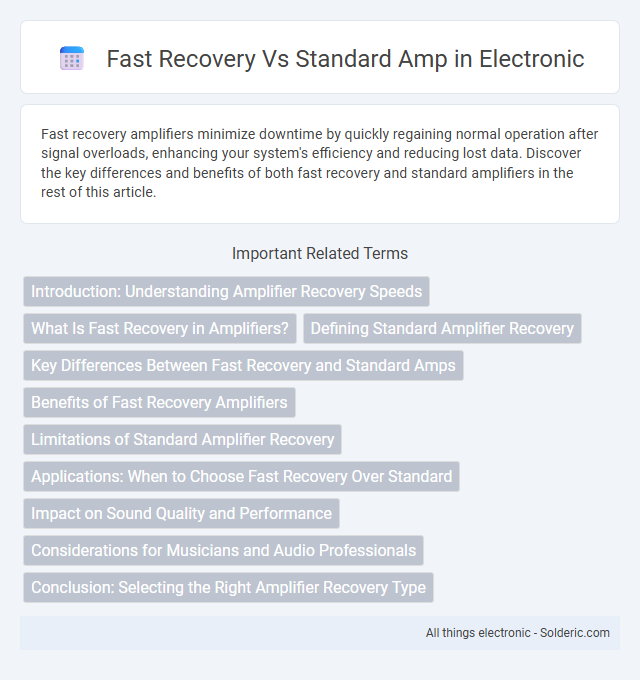Fast recovery amplifiers minimize downtime by quickly regaining normal operation after signal overloads, enhancing your system's efficiency and reducing lost data. Discover the key differences and benefits of both fast recovery and standard amplifiers in the rest of this article.
Comparison Table
| Feature | Fast Recovery Amplifier | Standard Amplifier |
|---|---|---|
| Recovery Time | Milliseconds, optimized for rapid signal stabilization | Slower, can take seconds to stabilize after signal drop |
| Signal Distortion | Minimal due to quick recovery mechanisms | Higher distortion during signal transitions |
| Application | High-speed data transmission, pulse amplifying | General purpose amplification, audio, low-frequency signals |
| Power Consumption | Typically higher due to fast switching components | Lower, optimized for steady-state efficiency |
| Cost | Higher, advanced components and design | Lower, simpler designs |
Introduction: Understanding Amplifier Recovery Speeds
Fast recovery amplifiers significantly reduce the time needed to return to normal operation after a high-level input signal overload, improving signal clarity and system responsiveness. Standard amplifiers, while reliable, typically exhibit longer recovery times that can cause temporary signal distortion or loss, affecting overall performance. Choosing the right recovery speed for Your amplifier directly influences the efficiency and accuracy of electronic communication or measurement systems.
What Is Fast Recovery in Amplifiers?
Fast recovery in amplifiers refers to the ability of the amplifier's components, particularly diodes and transistors, to quickly return to their normal operating state after being driven into saturation or overload. This rapid transition minimizes distortion and switching losses, enhancing the overall efficiency and audio fidelity of the amplifier. Compared to standard amplifiers, fast recovery designs enable better performance at high frequencies and during transient signal changes.
Defining Standard Amplifier Recovery
Standard amplifier recovery refers to the time it takes for an amplifier to return to its normal operating state after experiencing a large signal or overload. This recovery period impacts audio accuracy and the amplifier's ability to handle dynamic signals without distortion. Understanding standard amplifier recovery times is crucial for optimizing sound quality and preventing signal clipping in high-fidelity audio systems.
Key Differences Between Fast Recovery and Standard Amps
Fast recovery amps feature quicker diode switching times, reducing power loss and improving efficiency compared to standard amps with slower recovery rates. These amps typically generate less heat and offer enhanced performance in high-frequency applications, making them ideal for modern audio systems. Choosing fast recovery can optimize Your amplifier's responsiveness and overall sound quality.
Benefits of Fast Recovery Amplifiers
Fast recovery amplifiers minimize signal distortion by rapidly returning to baseline after high-level input signals, enhancing the accuracy of high-frequency and transient signal processing. These amplifiers improve system performance in communication and radar applications by reducing downtime and ensuring reliable signal amplification under dynamic conditions. You benefit from faster response times and increased signal integrity, making fast recovery amplifiers ideal for precision measurement and high-speed electronics.
Limitations of Standard Amplifier Recovery
Standard amplifiers experience slower recovery times due to inherent circuit design limitations, resulting in prolonged distortion and signal degradation after overload or clipping events. These amplifiers often cause extended transient response delays, reducing audio clarity and increasing noise interference during rapid signal changes. The limited slew rate and bandwidth in standard amplifier recovery hinder efficient handling of high-frequency signals, impacting overall sound fidelity and dynamic performance.
Applications: When to Choose Fast Recovery Over Standard
Fast recovery diodes excel in applications requiring high-speed switching and reduced reverse recovery time, such as power supplies, inverters, and motor drives, enhancing efficiency and minimizing power loss. These diodes are preferred in circuits operating at high frequencies or where fast switching reduces electromagnetic interference (EMI). Your choice should favor fast recovery diodes when rapid switching performance and thermal management are critical, while standard diodes are better suited for low-frequency or less demanding applications.
Impact on Sound Quality and Performance
Fast recovery amplifiers minimize distortion and improve transient response, resulting in clearer, more dynamic sound reproduction with enhanced detail and reduced signal degradation. Standard amplifiers typically have slower recovery times, which can introduce audible distortion and limit the amplifier's ability to accurately reproduce fast transient signals, impacting overall sound clarity. The performance difference is significant in high-fidelity audio systems where fast recovery amps provide superior accuracy and transient handling.
Considerations for Musicians and Audio Professionals
Fast recovery amplifiers offer musicians and audio professionals enhanced transient response and clarity, making them ideal for capturing subtle nuances in live and studio performances. Standard amplifiers, while often more robust and warmer in tone, may introduce slight delays or distortions that affect precision in complex soundscapes. Your choice should balance the need for speed and accuracy with the desired tonal character to optimize audio quality in specific applications.
Conclusion: Selecting the Right Amplifier Recovery Type
Choosing between fast recovery and standard amplifier recovery depends on your specific application requirements and signal characteristics. Fast recovery amplifiers excel in high-speed, pulse, and transient signal processing, offering minimal distortion and quicker return to baseline, while standard amplifiers provide stable performance with lower noise in continuous wave signals. Your decision should consider speed, distortion tolerance, and noise levels to ensure optimal amplifier performance for your system.
Fast recovery vs Standard amp Infographic

 solderic.com
solderic.com